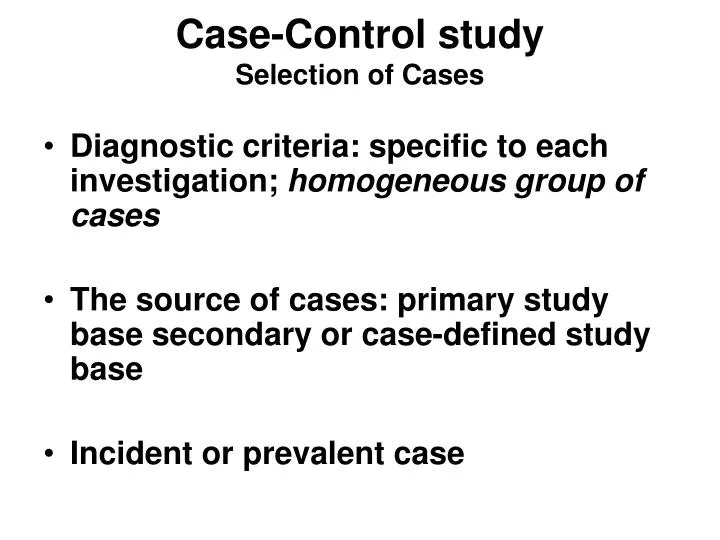
Cohabitants sharing rooms and talking for 30 min or more were at higher risk among non-cohabitants, the exposure to 1 or more COVID-19 cases, talking for 30 min or more, and the use of ride sharing were associated with a higher risk of infection ( 9). Secondary transmission was shown to occur more frequently among cohabitants than with other contacts, suggesting an increased risk of intrafamilial transmission of SARS-CoV-2 ( 8). The identification of the circumstances and the settings that determine a higher risk of severe acute respiratory syndrome coronavirus 2 (SARS-CoV-2) transmission can contribute to inform a more precise implementation of protective measures.Įcological studies identified individuals' socioeconomic status, and population density, overcrowding, and mobility as relevant infection determinants ( 4– 7). These restrictive measures contribute for a reduction in the incidence of COVID-19 cases but severely affect social and economic activities ( 3).
#Case control study full
Non-pharmaceutical measures range from recommendations to reduce social contacts to nationwide curfews, partial and full lockdowns, and closure of restaurants, bars, and other non-essential services ( 2). Overcrowding, foreign citizenship, low education and working on-site were positively associated with SARS-CoV-2 infection.īefore extended worldwide vaccination coverage is achieved, non-pharmaceutical measures remain an essential option to control COVID-19 pandemic in most countries ( 1). tertiary education: 1.79 1.33–2.42) and no Portuguese citizenship (5.47 3.43–9.22) were important risk factors.Ĭonclusions: The utilization of public transportation, restaurants, and commercial spaces was not associated with increased risk of infection, under capacity restrictions, physical distancing, use of masks, and hygiene measures. Going to restaurants/other dining spaces (0.73 0.59–0.91), grocery stores (0.44 0.34–0.57) or hair salons (0.51 0.39–0.66), or the use of public transportation did not present a higher risk of infection (0.98 0.75–1.29), under existing mitigation strategies. Results: Household overcrowding (aOR = 1.47 95% CI 1.14–1.91) and work in senior care (4.99 1.30–33.08) increased while working remotely decreased the risk of infection (0.30 0.22–0.42). We report sex-, age-, education-, and citizenship-adjusted odds ratios (aOR) with 95% confidence intervals (95% CI). Sociodemographic characteristics, individual protective measures, and activities or visited settings were obtained through telephone interview.

Methods: We evaluated 1,088 cases, identified through the national surveillance system, and 787 community controls, recruited using random digit dialing.

We thus designed a case-control study to identify relevant settings for community transmission of severe acute respiratory syndrome coronavirus 2 (SARS-CoV-2) in Portugal.

1NOVA National School of Public Health, Public Health Research Center, Universidade NOVA de Lisboa, Lisboa, Portugal.Andreia Leite 1,2 * †, Teresa Leão 3,4 * †, Patrícia Soares 1,2, Milton Severo 3,4, Marta Moniz 1,2, Raquel Lucas 3, Pedro Aguiar 1,2, Paula Meireles 3, Nuno Lunet 3,4, Carla Nunes 1,2 ‡ and Henrique Barros 3,4 ‡


 0 kommentar(er)
0 kommentar(er)
